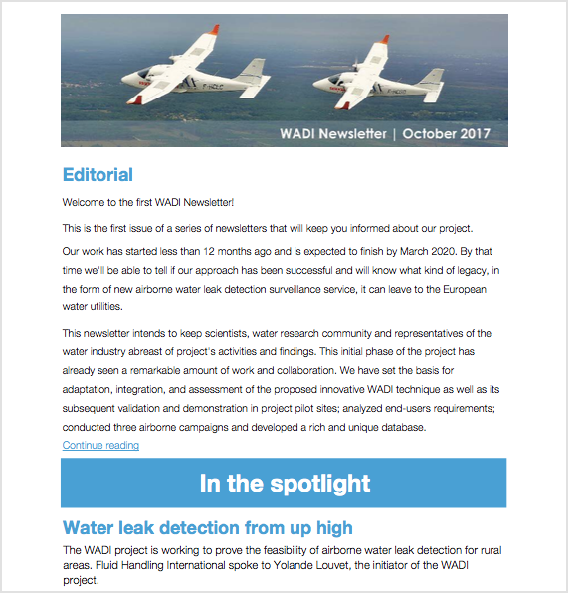Editorial
Welcome to the first WADI Newsletter!
This is the first issue of a series of newsletters that will keep you informed about our project.
Our work has started less than 12 months ago and is expected to finish by March 2020. By that time we’ll be able to tell if our approach has been successful and will know what kind of legacy, in the form of new airborne water leak detection surveillance service, it can leave to the European water utilities.
This newsletter intends to keep scientists, water research community and representatives of the water industry abreast of project’s activities and findings. This initial phase of the project has already seen a remarkable amount of work and collaboration. We have set the basis for adaptation, integration, and assessment of the proposed innovative WADI technique as well as its subsequent validation and demonstration in project pilot sites; analyzed end-users requirements; conducted three airborne campaigns and developed a rich and unique database. This is a complex and yet fundamental step which allowed us to determine optimal optical wavelengths for airborne leakage detection. A plane with dedicated instrumentations was flown over several districts in Provence with nested underground and open-air water ducts. Two hyperspectral cameras as well as a microbolometer infrared camera were used for providing hundreds of spectral images from the visible to the thermal infrared. The question was how to combine them to discriminate at best the water leakages from natural or manmade artefacts (trees, shadows, optical variations in land cover, let it be vegetation or bare soil). Based on a few areas with provoked leakages, a few solutions were proposed that generally yield significant contrasts. Another campaign has still to be processed and is intended to corroborate the final wavelength combination choice.
Finally, WADI is also proud to be new member of ICT4WATER, a cluster of 27 EU funded research projects on the theme of water management and water efficiency, and I invite you to monitor their excellent projects closely. Also see our recommended events to find out more on the 13th International Conference on Hydroinformatics (HIC 2018), 1-6 July, 2018 in Palermo, Italy, that will tighten collaboration with complementary initiatives on water management, and on the International Geoscience and Remote Sensing Symposium (IGARSS 2018), 23-27 July, 2018 in Valencia, Spain.
Our newsletter will be distributed twice a year. Please feel free to encourage other stakeholders or interested parties to subscribe to it, keep an eye on WADI and get in touch whenever you feel it would be appropriate to point us to new complementary initiatives.
Efficiently yours,
Jean-Claude KRAPEZ
WADI Interim Scientific Coordinator,
ONERA
